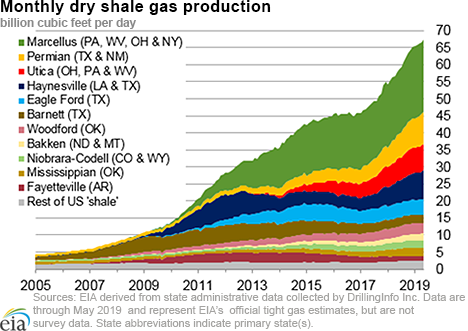In the News:
Renewable natural gas demand to increase with UPS purchase agreement
On May 22, 2019 United Parcel Service (UPS), a global provider of shipping and delivery services, announced that the company would increase its use of renewable natural gas (RNG) in the United States. UPS purchased 170 million gasoline gallon equivalent (gge) from fuel supplier Clean Energy Fuels to meet this commitment, which supports UPS’s sustainability goals. RNG consumption has increased significantly in recent years, and according to UPS, this agreement will be the largest commitment to RNG to date by any company in the United States.
RNG is a transportation fuel derived from biogas through anaerobic digestion at landfills and other facilities. The biogas is cleaned of impurities and upgraded to meet the pipeline specifications for natural gas. The RNG can then be consumed as fuel in CNG and LNG vehicles, a common fuel alternative for medium- and heavy-duty vehicles that would otherwise run on diesel fuel.
RNG consumption in the United States increased significantly following a 2014 EPA ruling that allowed RNG, in either compressed or liquefied form, to qualify as a cellulosic biofuel as part of the Renewable Fuel Standard. According to the U.S. Environmental Protection Agency, nearly 270 million ethanol gallon equivalent (or about 185 million gge) of RNG were produced in 2018, a 133% increase compared with 2015 levels. More than 50 facilities are registered with EPA to produce RNG, and EIA expects additional production to enter service as a result of capacity additions already under construction.
The UPS/Clean Energy Fuels agreement requires UPS to purchase 170 million gge of RNG from Clean Energy Fuels between 2019 and 2026, amounting to sales of about 22.5 million gge per year, or about 10% of current RNG production levels. Clean Energy Fuels will supply the RNG to UPS fueling stations in 18 cities across 12 states.
UPS has been steadily incorporating RNG into its transportation fleet, consuming more than 28 million gge of RNG since 2014, including 15 million gge in 2017 alone. UPS currently owns a global fleet of 5,200 natural gas vehicles. In the United States, UPS operates 51 fueling stations capable of supplying natural gas to its ground fleet.
In 2017, UPS purchased 115 million gallons of alternative fuel (RNG, biodiesel, and ethanol), representing 21.8% of its total ground fleet operations. The company plans to displace 40% of its ground fuel (conventional gasoline and diesel) use with low carbon and alternative fuels by 2025. The company also plans to achieve a 12% reduction in greenhouse gas emissions associated with its global ground operations by 2025 relative to 2015.
Overview:
(For the week ending Wednesday, July 10, 2019)
- Natural gas spot prices rose at most locations this report week (Wednesday, July 3 to Wednesday, July 10). Henry Hub spot prices rose from $2.24 per million British thermal units (MMBtu) last Wednesday to $2.46/MMBtu yesterday.
- At the New York Mercantile Exchange (Nymex), the price of the August 2019 contract increased 15¢, from $2.29/MMBtu last Wednesday to $2.444/MMBtu yesterday. The price of the 12-month strip averaging August 2019 through July 2020 futures contracts climbed 14¢/MMBtu to $2.575/MMBtu.
- Net injections to working gas totaled 81 billion cubic feet (Bcf) for the week ending July 5. Working natural gas stocks are 2,471 Bcf, which is 13% more than the year-ago level and 5% lower than the five-year (2014–18) average for this week.
- The natural gas plant liquids composite price at Mont Belvieu, Texas, rose by 7¢/MMBtu, averaging $4.53/MMBtu for the week ending July 10. The prices of ethane and propane fell by 5% and 2%, respectively. The prices of isobutane, butane, and natural gasoline rose by 15%, 7%, and 3%, respectively.
- According to Baker Hughes, for the week ending Tuesday, July 2, the natural gas rig count increased by 1 to 174. The number of oil-directed rigs fell by 5 to 788. The total rig count decreased by 4, and it now stands at 963.
Prices/Supply/Demand:
Prices end at weekly highs at most trading hubs as temperatures continue to rise. This report week (Wednesday, July 3 to Wednesday, July 10), Henry Hub spot prices rose 22¢ from $2.24/MMBtu last Wednesday to a weekly high of $2.46/MMBtu yesterday. At the Chicago Citygate, prices increased 31¢ from $2.01/MMBtu last Wednesday to a weekly high of $2.32/MMBtu yesterday. Prices rose as the eastern United States experienced warmer-than-normal-temperatures throughout the week. In addition, the National Oceanographic and Atmospheric Administration (NOAA) forecasted a high probability of above-normal temperatures persisting over the coming weeks, particularly in the Northeast and Midwest, putting upward pressure on prices because of increased demand for space cooling.
Southern California Gas transmission and distribution systems were largely unaffected by the earthquakes. Prices at SoCal Citygate increased 66¢ from $1.87/MMBtu last Wednesday to $2.53/MMBtu yesterday following some price volatility with the earthquakes and aftershocks over the holiday weekend. Southern California Gas reported no significant impact on their transmission and distribution systems. The epicenter in Ridgecrest (150 miles northeast of Los Angeles) is not directly on the pipeline system. Prices at PG&E Citygate in Northern California rose 97¢, up from $1.95/MMBtu last Wednesday to $2.92/MMBtu yesterday.
Northeast prices rise with warmer-than-normal temperatures. Prices across the eastern seaboard were slightly warmer-than-normal during the report week, driving up cooling demand in population centers. At the Algonquin Citygate, which serves Boston-area consumers, prices went up 35¢ from $2.09/MMBtu last Wednesday to $2.44/MMBtu yesterday. At the Transcontinental Pipeline Zone 6 trading point for New York City, prices increased 40¢ from $1.98/MMBtu last Wednesday to $2.38/MMBtu yesterday.
Tennessee Zone 4 Marcellus spot prices increased 37¢ from $1.84/MMBtu last Wednesday to $2.21/MMBtu yesterday. Prices at Dominion South in southwest Pennsylvania rose 30¢ from $1.90/MMBtu last Wednesday to $2.20/MMBtu yesterday.
Permian Basin prices end the week in positive territory. Prices at the Waha Hub in West Texas, which is located near Permian Basin production activities, averaged -$0.01/MMBtu last Wednesday, $2.25/MMBtu lower than Henry Hub prices. Yesterday, prices at the Waha Hub averaged $0.68/MMBtu, $1.78/MMBtu lower than Henry Hub prices.
Supply is flat. According to data from PointLogic Energy, the average total supply of natural gas remained the same as in the previous report week, averaging 95.7 Bcf/d. Dry natural gas production grew by 1% compared with the previous report week. Average net imports from Canada decreased by 4% from last week.
Total demand is down slightly, despite increase in power burn. Total U.S. consumption of natural gas fell by 1% compared with the previous report week, according to data from PointLogic Energy. Natural gas consumed for power generation climbed by 1% week over week. Industrial sector consumption decreased by 5% week over week. In the residential and commercial sectors, consumption declined by 4%. Natural gas exports to Mexico increased 1% and reached a three-week high of 5.5 Bcf/d according to Genscape, as the population center of Monterrey, Mexico, experienced high temperatures and increased cooling demand.
A tropical depression is affecting Gulf Coast energy markets. Current forecasts show Tropical Storm Barry will make landfall in Louisiana and Texas over the next several days. The Gulf of Mexico area, both onshore and offshore, is one of the most important regions for energy resources and infrastructure. EIA’s map of energy infrastructure with real-time storm information shows energy infrastructure that is within the track of the storm. Offshore natural gas production is down about 50% week over week because some operators have temporarily shuttered production. Heavy rains, cooler weather, and potential infrastructure outages because of flooding could reduce natural gas demand.
U.S. LNG exports increase week over week. Twelve LNG vessels (seven from Sabine Pass, two from Cove Point, two from Corpus Christi, and one from Cameron) with a combined LNG-carrying capacity of 44 Bcf departed the United States between July 4 and July 10, according to shipping data compiled by Bloomberg. One vessel was loading at the Sabine Pass terminal on Wednesday.
Natural gas feedstock deliveries to U.S. liquefaction facilities set a new record last week, reaching 6.3 billion cubic feet per day (Bcf/d) on July 4 and July 7, 2019. They averaged 6.1 Bcf/d for the report week—the highest weekly average to date—according to PointLogic Energy data. Flows to the newly commissioned Cameron Train 1 and Corpus Christi Train 2 increased, indicating that both trains have ramped up feedstock deliveries to full capacity.
Last week, the first cargo was loaded with LNG produced at the newly-commissioned Train 2 at the Corpus Christi LNG facility. The Corpus Christi terminal in Texas consists of three trains, each with a baseload nameplate capacity of 0.6 Bcf/d. Two trains are now fully operational. The third train is under construction and is expected to come online in May 2021.
Storage:
Net injections into storage totaled 81 Bcf for the week ending July 5, compared with the five-year (2014–18) average net injections of 71 Bcf and last year's net injections of 55 Bcf during the same week. Working gas stocks totaled 2,471 Bcf, which is 142 Bcf lower than the five-year average and 275 Bcf more than last year at this time.
According to The Desk survey of natural gas analysts, estimates of the weekly net change from working natural gas stocks ranged from net injections of 65 Bcf to 93 Bcf, with a median estimate of 77 Bcf.
The average rate of net injections into storage is 37% higher than the five-year average so far in the refill season (April through October). If the rate of injections into storage matched the five-year average of 9.1 Bcf/d for the remainder of the refill season, total inventories would be 3,550 Bcf on October 31, which is 142 Bcf lower than the five-year average of 3,692 Bcf for that time of year. "
More storage data and analysis can be found on the Natural Gas Storage Dashboard and the Weekly Natural Gas Storage Report.
See also:
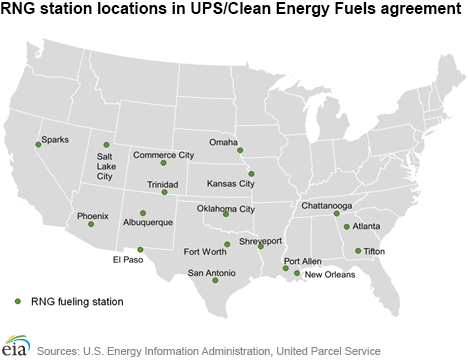
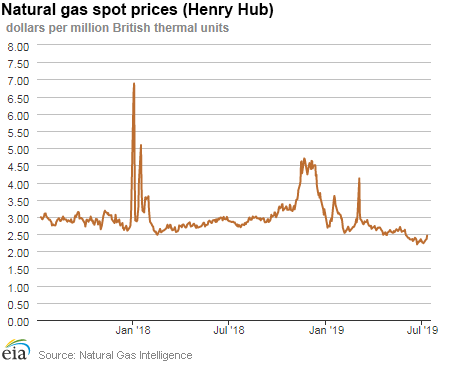
| Spot Prices ($/MMBtu) | Thu, 4-Jul |
Fri, 5-Jul |
Mon, 8-Jul |
Tue, 9-Jul |
Wed, 10-Jul |
|---|---|---|---|---|---|
| Henry Hub | Holiday | Closed | 2.35 | 2.36 | 2.46 |
| New York | Holiday | Closed | 2.23 | 2.31 | 2.38 |
| Chicago | Holiday | Closed | 2.13 | 2.15 | 2.32 |
| Cal. Comp. Avg,* | Holiday | Closed | 7.07 | 6.62 | 7.68 |
| Futures ($/MMBtu) | |||||
| August Contract | Holiday | 2.418 | 2.403 | 2.425 | 2.444 |
| September Contract | Holiday | 2.389 | 2.384 | 2.416 | 2.433 |
| *Avg. of NGI's reported prices for: Malin, PG&E Citygate, and Southern California Border Avg. | |||||
| Source: NGI's Daily Gas Price Index | |||||
| Spot Prices ($/MMBtu) | Thu, 27-Jun |
Fri, 28-Jun |
Mon, 1-Jul |
Tue, 2-Jul |
Wed, 3-Jul |
|---|---|---|---|---|---|
| Henry Hub | 2.30 | 2.35 | 2.26 | 2.25 | 2.24 |
| New York | 2.11 | 2.08 | 2.13 | 2.11 | 1.98 |
| Chicago | 2.09 | 2.11 | 2.04 | 2.08 | 2.01 |
| Cal. Comp. Avg,* | 5.90 | 6.57 | 6.24 | 5.63 | 5.50 |
| Futures ($/MMBtu) | |||||
| August Contract | 2.324 | 2.308 | 2.267 | 2.240 | 2.290 |
| September Contract | 2.298 | 2.282 | 2.242 | 2.217 | 2.263 |
| *Avg. of NGI's reported prices for: Malin, PG&E Citygate, and Southern California Border Avg. | |||||
| Source: NGI's Daily Gas Price Index | |||||
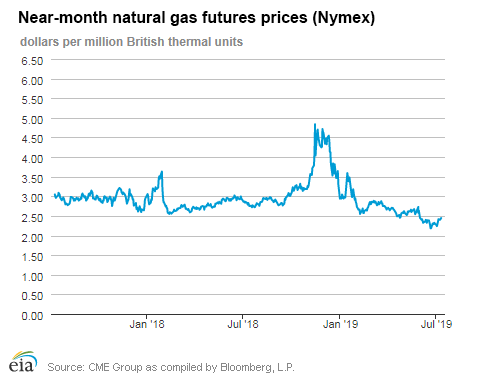
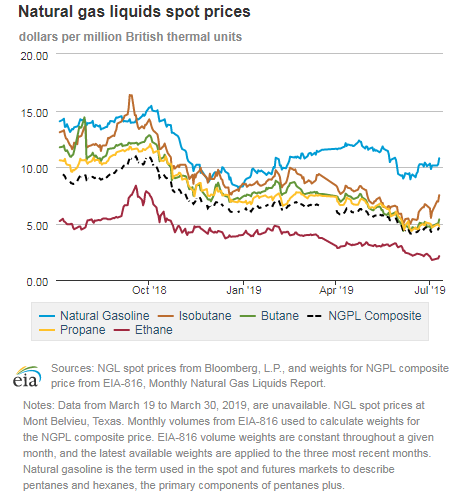
| U.S. natural gas supply - Gas Week: (7/4/19 - 7/10/19) | |||
|---|---|---|---|
Average daily values (Bcf/d): |
|||
this week |
last week |
last year |
|
| Marketed production | 101.5 |
100.7 |
95.0 |
| Dry production | 90.3 |
89.8 |
84.1 |
| Net Canada imports | 5.3 |
5.5 |
6.0 |
| LNG pipeline deliveries | 0.1 |
0.1 |
0.1 |
| Total supply | 95.7 |
95.3 |
90.1 |
|
Source: OPIS PointLogic Energy, an IHS Company | |||
| U.S. natural gas consumption - Gas Week: (7/4/19 - 7/10/19) | |||
|---|---|---|---|
Average daily values (Bcf/d): |
|||
this week |
last week |
last year |
|
| U.S. consumption | 67.2 |
68.2 |
66.2 |
| Power | 39.3 |
38.8 |
37.8 |
| Industrial | 20.4 |
21.5 |
20.8 |
| Residential/commercial | 7.5 |
7.9 |
7.6 |
| Mexico exports | 4.9 |
4.8 |
4.8 |
| Pipeline fuel use/losses | 6.2 |
6.2 |
5.9 |
| LNG pipeline receipts | 6.1 |
6.0 |
3.3 |
| Total demand | 84.4 |
85.1 |
80.1 |
|
Source: OPIS PointLogic Energy, an IHS Company | |||
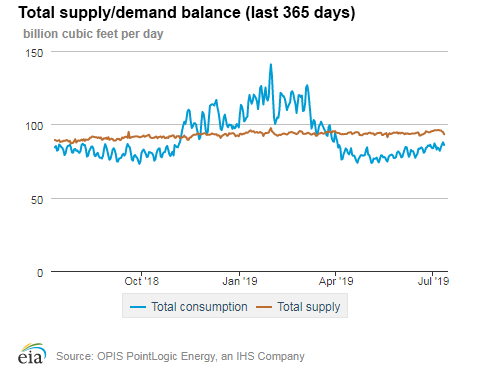
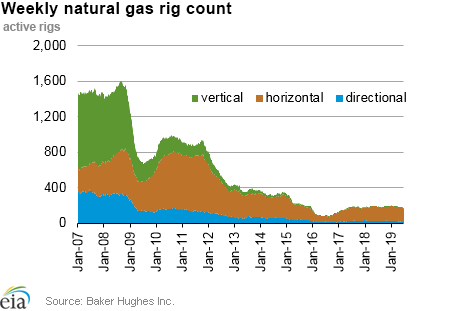
| Rigs | |||
|---|---|---|---|
Tue, July 02, 2019 |
Change from |
||
last week |
last year |
||
| Oil rigs | 788 |
-0.6% |
-8.7% |
| Natural gas rigs | 174 |
0.6% |
-7.0% |
| Note: Excludes any miscellaneous rigs | |||
| Rig numbers by type | |||
|---|---|---|---|
Tue, July 02, 2019 |
Change from |
||
last week |
last year |
||
| Vertical | 58 |
-1.7% |
5.5% |
| Horizontal | 839 |
-0.1% |
-9.8% |
| Directional | 66 |
-2.9% |
-1.5% |
| Source: Baker Hughes Inc. | |||
| Working gas in underground storage | ||||
|---|---|---|---|---|
Stocks billion cubic feet (Bcf) |
||||
| Region | 2019-07-05 |
2019-06-28 |
change |
|
| East | 544 |
526 |
18 |
|
| Midwest | 597 |
568 |
29 |
|
| Mountain | 140 |
134 |
6 |
|
| Pacific | 263 |
255 |
8 |
|
| South Central | 927 |
907 |
20 |
|
| Total | 2,471 |
2,390 |
81 |
|
|
Source: Form EIA-912, Weekly Underground Natural Gas Storage Report | ||||
| Working gas in underground storage | |||||
|---|---|---|---|---|---|
Historical comparisons |
|||||
Year ago (7/5/18) |
5-year average (2014-2018) |
||||
| Region | Stocks (Bcf) |
% change |
Stocks (Bcf) |
% change |
|
| East | 477 |
14.0 |
561 |
-3.0 |
|
| Midwest | 474 |
25.9 |
610 |
-2.1 |
|
| Mountain | 142 |
-1.4 |
165 |
-15.2 |
|
| Pacific | 260 |
1.2 |
290 |
-9.3 |
|
| South Central | 843 |
10.0 |
987 |
-6.1 |
|
| Total | 2,196 |
12.5 |
2,613 |
-5.4 |
|
| Source: Form EIA-912, Weekly Underground Natural Gas Storage Report | |||||
| Temperature – heating & cooling degree days (week ending Jul 04) | ||||||||
|---|---|---|---|---|---|---|---|---|
HDD deviation from: |
CDD deviation from: |
|||||||
| Region | HDD Current |
normal |
last year |
CDD Current |
normal |
last year |
||
| New England | 0 |
-3 |
0 |
54 |
24 |
-29 |
||
| Middle Atlantic | 0 |
-1 |
0 |
72 |
27 |
-25 |
||
| E N Central | 0 |
-2 |
0 |
89 |
41 |
-7 |
||
| W N Central | 0 |
-4 |
0 |
89 |
27 |
-2 |
||
| South Atlantic | 0 |
0 |
0 |
112 |
22 |
2 |
||
| E S Central | 0 |
0 |
0 |
101 |
15 |
-11 |
||
| W S Central | 0 |
0 |
0 |
114 |
-3 |
-27 |
||
| Mountain | 1 |
-9 |
-2 |
76 |
6 |
-1 |
||
| Pacific | 3 |
-4 |
-1 |
29 |
-6 |
-4 |
||
| United States | 1 |
-2 |
0 |
82 |
16 |
-10 |
||
|
Note: HDD = heating degree day; CDD = cooling degree day Source: National Oceanic and Atmospheric Administration | ||||||||
Average temperature (°F)
7-day mean ending Jul 04, 2019
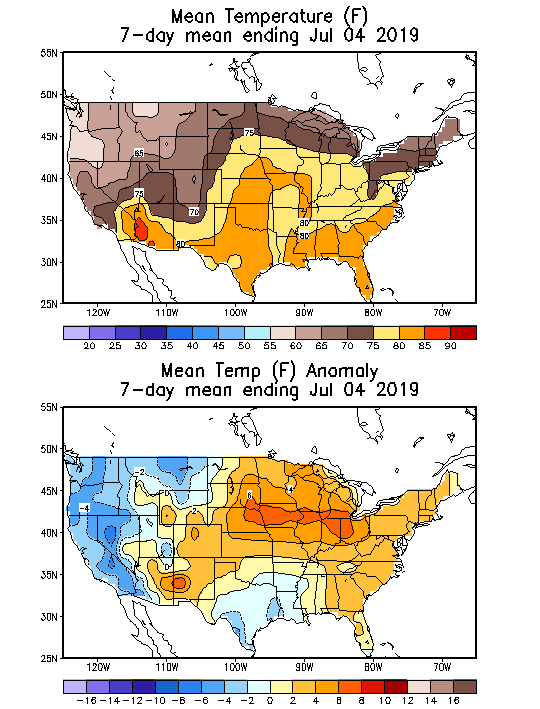
Source: National Oceanic and Atmospheric Administration
Deviation between average and normal (°F)
7-day mean ending Jul 04, 2019

Source: National Oceanic and Atmospheric Administration

